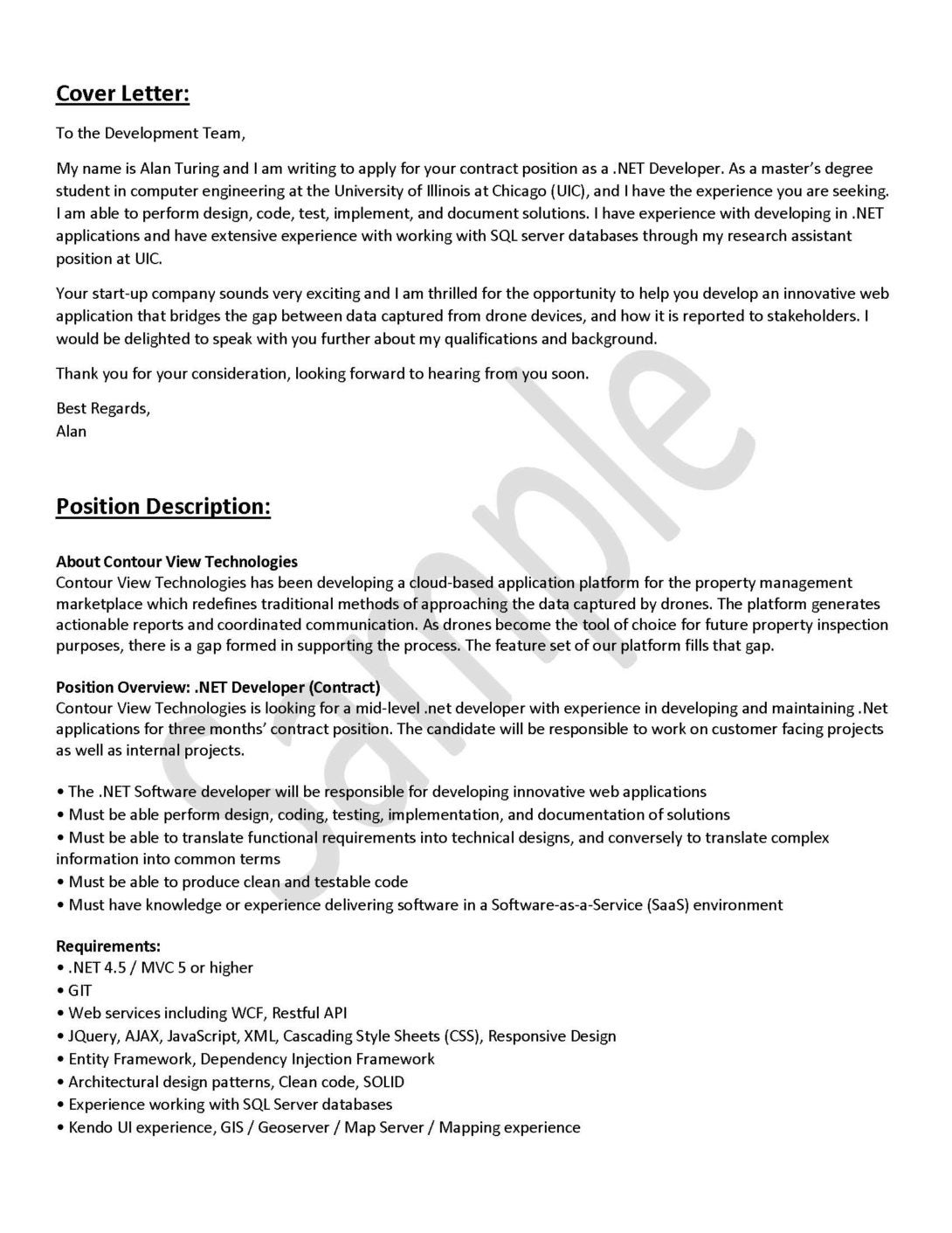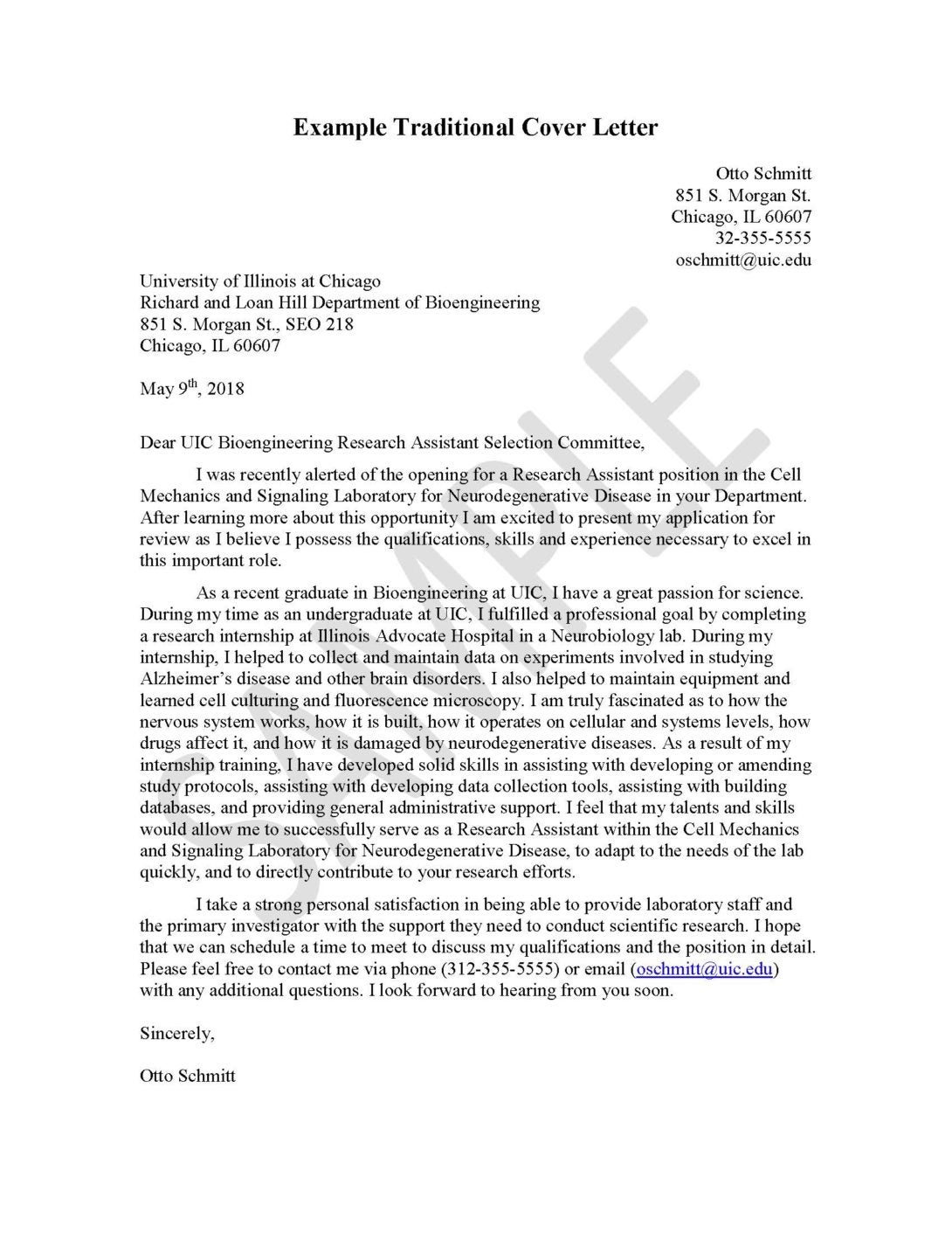Cover Letter
What is a cover letter and should you write one?
A cover letter (also known as an application letter) is a document used to explain why you are applying to a job and/or internship. It's purpose originated to literally be a letter to cover a resume (established back when we used to apply for jobs in paper form).
The goal of the cover letter is to sell yourself by showing how you posses skills that match a company's job description. Here are a few tips how to write an excellent cover letter as well as how to determine if you need to write one at all.
Cover Letter Tips Heading link
-
Do I Have to Write a Cover Letter?
- When Not To Write a Cover Letter:
- Large companies (500 employees or more) usually do not require a cover letter when applying for a job or internship. Recruiters from large companies have even advised us to inform students not to write cover letters since they often do not have time to read them due to the number of applications they receive.
- With the advent of online applications, there has been a decline in the necessity to prepare cover letters, since companies now have the ability to receive large volumes of applications electronically.
- Declines in cover letters for applications are also seen more readily in STEM fields (science, technology, engineering, and mathematics).
- Do not write a cover letter if it is a “template” cover letter, where you merely changed the company name and job title. Remember, engineers and developers are reading your cover letter; they can tell when they are reading a “template” cover letter. Cover letters need to be tailored to specifically to each company.
- Do not write a cover letter if you are crunched for time and need to submit your application quickly. Cover letters must be flawlessly written, which can take time to write and revise. Make sure to edit your cover letter multiple times to avoid any typos, or run-on sentences.
- When To Write a Cover Letter:
- Some job and/or internship applications will contain a field in the application to upload a cover letter. If you encounter an application that has a field to upload a cover letter, you should consider writing a cover letter. If the field to upload a cover letter is marked as required or if the job description specifically requests a cover letter, you should definitely write a cover letter.
- It is also recommended to write a cover letter if you have special insight into a company – such as you know someone who works there, are familiar with a specific project the company is working on, or you have direct experience in a skill that the company is hiring for. A cover letter highlighting your specific knowledge of a company, a unique skill, or mention of a referral by a current employee, can help you land an interview.
- When Not To Write a Cover Letter:
-
What is the Basic Format?
- Cover letters are never more than one page in length.
- Will typically contain 3-4 paragraphs:
- An introduction paragraph.
- 1-2 support paragraphs.
- One short conclusion paragraph.
- Must contain your name, email, phone number, and date (your mailing address is optional).
- Consider copying your name and contact information exactly as it is formatted from your resume to your cover letter. This is a way to demonstrate that both the resume and the cover letter are part of the same application.
- Your personal website links, LinkedIn, or other social media links are optional to include.
- Must contain the name of the company that you are applying to and the company’s mailing address (if you can find it).
- Must contain the name of the position that you are applying for in the body of the cover letter.
- Must contain a closing salutation, such as:
- Sincerely, Tom
- Best Wishes, Grace
- Take Care, Dakota
- Many Thanks, Maria
-
Who Do I Address My Letter To?
- If possible, try to direct your cover letter to a specific person – if you know who the hiring manager is for the position, direct your cover letter to them (e.g. Dear Ms. Riley). Never use “Mrs.” when addressing someone; instead use “Ms.” or “Mr.”
- If you don’t know who the hiring manager is, do some research! Consider looking up the company on LinkedIn, Glassdoor, or network through your friends, professors, or other students you know who may have worked/interned at the company you are applying to.
- If you are still unsure of who to direct your cover letter to, here are a few ideas:
- Dear Engineer Selection Committee,
- Dear Development Team,
- To the Summer Internship Hiring Team,
- Dear Project Manager Recruitment Manager,
- To the Engineer Search Committee
-
Do I have to Tailor My Letter?
- Yes. Remember that engineers, developers, and seasoned recruiting professionals will be reading your cover letter. They can tell if you have written a template cover letter.
- You will need to individualize your cover letter for each job you apply for because no two jobs/companies are exactly the same.
- We realize that you may be applying to many positions and writing tailored cover letters can be time-consuming.
- Consider meeting with a member of the Engineering Career Center to help you develop strategies for writing tailored cover letters.
- Consider whether you really need to write a cover letter for every position you apply to. (See “Do I Have to Write a Cover Letter?” section on this page.)
-
What do I Write About?
- Before you start writing, make sure you have a copy of the position description you are applying for handy.
- Read the position description carefully. Highlight or isolate key words or phrases in the position description that you know you can do (or are excited to learn to do, or are very interested in doing).
- Introduction paragraph: describe why you are interested in working/interning at the company specifically.
- Thoroughly research the company thoroughly so you can write an genuine response.
- Don’t simply look at the company’s mission website, or “About” page. Use LinkedIn, Twitter, Wikipedia, Glassdoor, as well as search for them in the news to uncover recent and relevant information about them.
- Body/Support paragraph(s): copy bullets directly from the job description into the body of your cover letter and connect them with specific examples from your experiences, to highlight alignment with what the employer is seeking.
- Do not simply copy/paste bullet points from your resume. You do not want to say the exact same thing in two places!
- Describe what makes you qualified for the role based on the specific qualifications that they are seeking. Describe what sets you apart from other applicants.
- Write a conclusion with an invitation to be contacted at any time for any additional questions. Detail your enthusiasm again for the copy and/or position you are applying for.
- Before you start writing, make sure you have a copy of the position description you are applying for handy.
-
Cover Letter Examples

- Notice how the position description (for a contract developer) is located at the bottom of the document.
- Notice how there is similar language in the position description that was also used in the cover letter.
- This is a good cover letter length for use in email applications, applications with a text box, or even to use as a LinkedIn message.
-
Traditional Cover Letter Example

- Notice how the letter is formatted (location of contact information, location of company address, greeting salutation, date, etc.).
- Notice the length of the letter, it does not exceed one page.
- Notice the overall tone of the letter, it conveys enthusiasm for the position by using strong words such as “passion” and “fascinated” to describe the interest in the position and in science generally.
-
Cover Letter Guide
The Engineering Career Center Cover Letter Guide contains cover letter examples and detailed directions on how to format your cover letters.